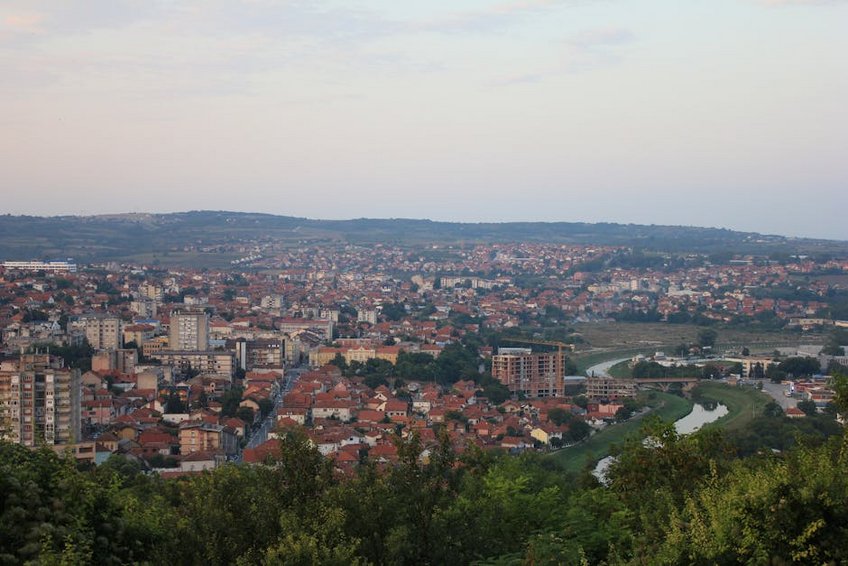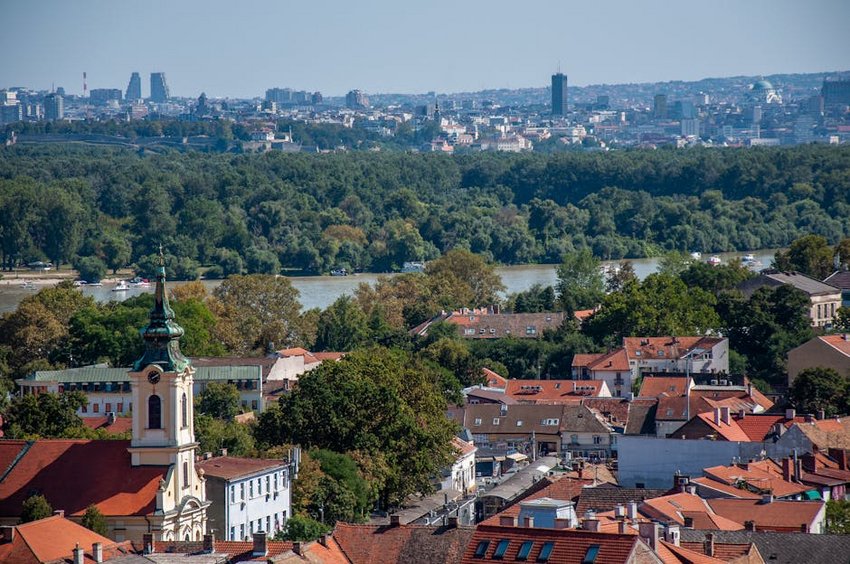Serbia’s Đavolja Varoš Rock Formations: A Geological Wonder
Serbia’s Đavolja Varoš rock formations present an otherworldly landscape of over 200 earth pyramids and stone towers shaped by millennia of erosion. These unique geological structures, nicknamed “Devil’s Town,” rise dramatically from the Radan Mountain slopes in southern Serbia, creating a surreal destination for nature enthusiasts and photographers. This guide covers essential travel tips, seasonal visits, budget planning, and cultural insights for exploring this Serbian natural monument.
Essential Geological Information
Đavolja Varoš features extraordinary earth pyramids capped with protective stone “hats” that prevent complete erosion. These formations reach heights up to 15 meters (49 feet) and continue evolving through natural processes. The site’s distinctive red and ochre colors come from mineral-rich soil compositions.
Scientific studies date these formations to the Holocene epoch, with erosion beginning approximately 100,000 years ago. Volcanic activity and seismic shifts initially created the landscape framework. Subsequent water erosion carved the intricate pillars visitors see today.
Located near the town of Kuršumlija in southern Serbia, the protected area spans 67 hectares (166 acres). Elevation ranges between 700-800 meters (2,300-2,625 feet) above sea level. The site gained protected status in 1959 and became a candidate for UNESCO World Heritage recognition.
Geological Formation Process
Understanding the creation process enhances appreciation for these natural sculptures.
- Water erosion selectively removes softer soil layers while leaving harder capstones intact, creating the distinctive pillar shapes over centuries.
- Freeze-thaw cycles during winter months accelerate erosion, with temperatures dropping to -15°C (5°F) and rising to 25°C (77°F) seasonally.
- Mineral composition variations create different erosion resistance, resulting in the fascinating structural diversity throughout the park.
- Budget travelers can manage on $35-50 USD daily using hostels, self-catering, and public transport, though reaching the formations might require shared taxis from Kuršumlija.
- Mid-range visitors spending $60-100 USD daily enjoy private guesthouses, restaurant meals, and rental cars, providing comfortable access to multiple sites in southern Serbia.
- Luxury experiences at $120-200 USD daily include boutique hotels, private guides, and all-inclusive tours that combine Đavolja Varoš with other Serbian highlights.
- National Tourism Organization of Serbia
- UNESCO World Heritage Tentative List
Location and Accessibility Details
Đavolja Varoš sits approximately 300 kilometers (186 miles) south of Belgrade near the Kosovo border. The drive from Serbia’s capital takes 4-5 hours via the E75 and regional roads. Public transportation options remain limited, requiring careful planning.
Regional buses connect Belgrade to Kuršumlija, but visitors need taxi transfers for the final 25 kilometers (15.5 miles) to the formations. Rental cars provide the most flexibility for exploring this remote area. Road conditions vary seasonally, with winter travel requiring 4WD vehicles.
Protected Area Regulations
The Serbian government designated Đavolja Varoš as a Category I natural monument, providing the highest protection level. Visitors must stay on marked trails to prevent soil erosion and damage. Photography permits aren’t required for personal use, but commercial shoots need advance authorization.
Entrance fees support conservation efforts, with adult tickets costing approximately $5 USD. Guided tours in English and Serbian operate daily from April through October. The visitor center provides educational exhibits about the geological processes and local ecosystem.

Alt: “serbia-devils-town-rock-formations-earth-pyramids-radan-mountain”
Planning Your Serbia Đavolja Varoš Rock Formations Trip
Your Serbia Đavolja Varoš rock formations adventure requires strategic timing between May and September for optimal weather conditions. Summer temperatures average 20-25°C (68-77°F) with minimal rainfall, perfect for hiking the marked trails. Early morning visits avoid both crowds and the midday heat that can reach 30°C (86°F).
Budget approximately $50-80 USD daily for mid-range travel, covering accommodation, meals, and local transportation. Rental cars cost $30-50 USD daily, while guided tours range from $25-60 USD per person. Entry fees remain affordable at $5-8 USD, with discounts for students and seniors.
Pack sturdy hiking shoes with ankle support for uneven terrain and layered clothing for temperature shifts. Bring sufficient water and snacks, as facilities are limited on-site. Download offline maps since mobile reception fluctuates in this mountainous region.
Best Time to Visit Đavolja Varoš
Visit between June and August for warm, dry conditions ideal for photography and hiking, with temperatures of 20-28°C (68-82°F). These months offer the clearest skies and longest daylight hours, though afternoon thunderstorms occasionally occur. Accommodation prices peak during this period, requiring advance bookings.
Shoulder seasons in May and September provide pleasant 15-22°C (59-72°F) temperatures with fewer visitors. Spring showcases wildflower blooms, while autumn features dramatic foliage contrasts. Winter visits from December to February offer snowy landscapes but limited access due to road conditions and temperatures from -5 to 5°C (23-41°F).
Budget Planning and Costs
Serbia offers excellent value, though remote locations like Đavolja Varoš require careful budgeting.
Essential Preparation Checklist
Pack waterproof hiking boots, moisture-wicking layers, and a windproof jacket for changeable mountain weather. Include a power bank, headlamp, and basic first aid supplies for remote exploration. Photography equipment should include polarizing filters and extra memory cards for capturing the formations.
EU and US passport holders can enter Serbia visa-free for up to 90 days, but check current entry requirements. Purchase comprehensive travel insurance covering medical evacuation from remote areas. Book accommodations 2-3 months ahead for summer visits, especially near the protected area.
Top Attractions and Activities
Beyond the iconic earth pyramids, the surrounding Radan Mountain area offers rich hiking trails through mixed forests and traditional villages. The Devil’s Water spring features highly acidic water with pH levels around 1.5, creating a unique natural phenomenon. Local legends attribute mystical properties to this red-colored water source.
Several viewing platforms provide different perspectives of the stone formations, with the highest offering panoramic vistas of the entire valley. Marked trails range from easy 30-minute walks to challenging 3-hour hikes connecting multiple geological points. Information plaques explain the scientific background and folk tales associated with various formations.
Must-See Highlights
The main earth pyramid group contains the most photogenic formations, particularly during golden hour when shadows accentuate their shapes. Arrive before 10 AM to avoid crowds and capture the best light. These pillars stand 10-15 meters (33-49 feet) tall with distinctive stone caps.
Devil’s Water spring displays vibrant mineral deposits and unique aquatic conditions unlike anywhere else in Serbia. The water’s acidity prevents most plant growth, creating a stark contrast with the surrounding vegetation. Scientists continue studying its chemical composition and origins.
The visitor center museum provides fascinating context through interactive displays and geological samples. Allow 45-60 minutes to explore the exhibitions covering formation processes, local ecology, and cultural significance. Knowledgeable staff can answer detailed questions about the protected area.
Hidden Gems and Local Favorites
Few visitors explore the eastern trail leading to smaller, equally impressive formations away from the main crowd areas. This path winds through beech forests before revealing secluded earth pyramids with different erosion patterns. The quiet atmosphere enhances the mystical experience.
Nearby traditional villages like Bela Voda offer authentic Serbian hospitality and homemade cuisine. Family-run restaurants serve regional specialties including kajmak (dairy spread) and grilled meats. Locals share folk stories about the formations that you won’t find in guidebooks.
Hiking and Photography Tips
Early morning light creates dramatic shadows highlighting the pillars’ textures and dimensions. Use polarizing filters to reduce glare and enhance the red soil colors. Telephoto lenses compress perspectives, while wide angles capture the landscape scale.
Sturdy footwear is essential for navigating the uneven trails and slippery sections after rain. Pack extra water as no drinking sources exist along the routes. Allow 2-3 hours minimum to fully experience the main trails and photography points at a comfortable pace.
Practical Travel Information
Southern Serbia’s infrastructure continues developing, with improved roads making Đavolja Varoš more accessible than ever. Recent tourism investments enhanced visitor facilities while maintaining the site’s natural integrity. English signage helps international visitors navigate the area.
Accommodation options range from basic guesthouses to comfortable hotels in nearby towns. Kuršumlija offers the closest lodging, while Niš provides more variety 90 minutes away. Advance reservations become essential during summer months and Serbian holidays.
| Accommodation Type | Features and Location | Price Range (USD) |
|---|---|---|
| Guesthouses | Family-run, traditional meals, limited English | $25-40/night |
| Mid-Range Hotels | Private bathrooms, WiFi, restaurant access | $45-75/night |
| Boutique Properties | Design elements, guided tours, premium amenities | $80-120/night |
| Vacation Rentals | Full kitchens, multiple bedrooms, self-catering | $60-100/night |


